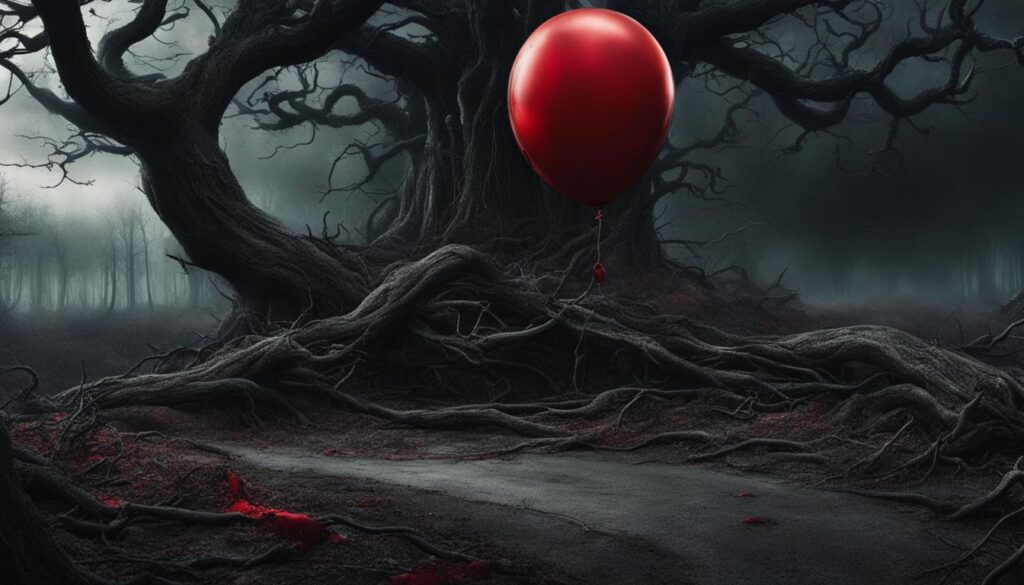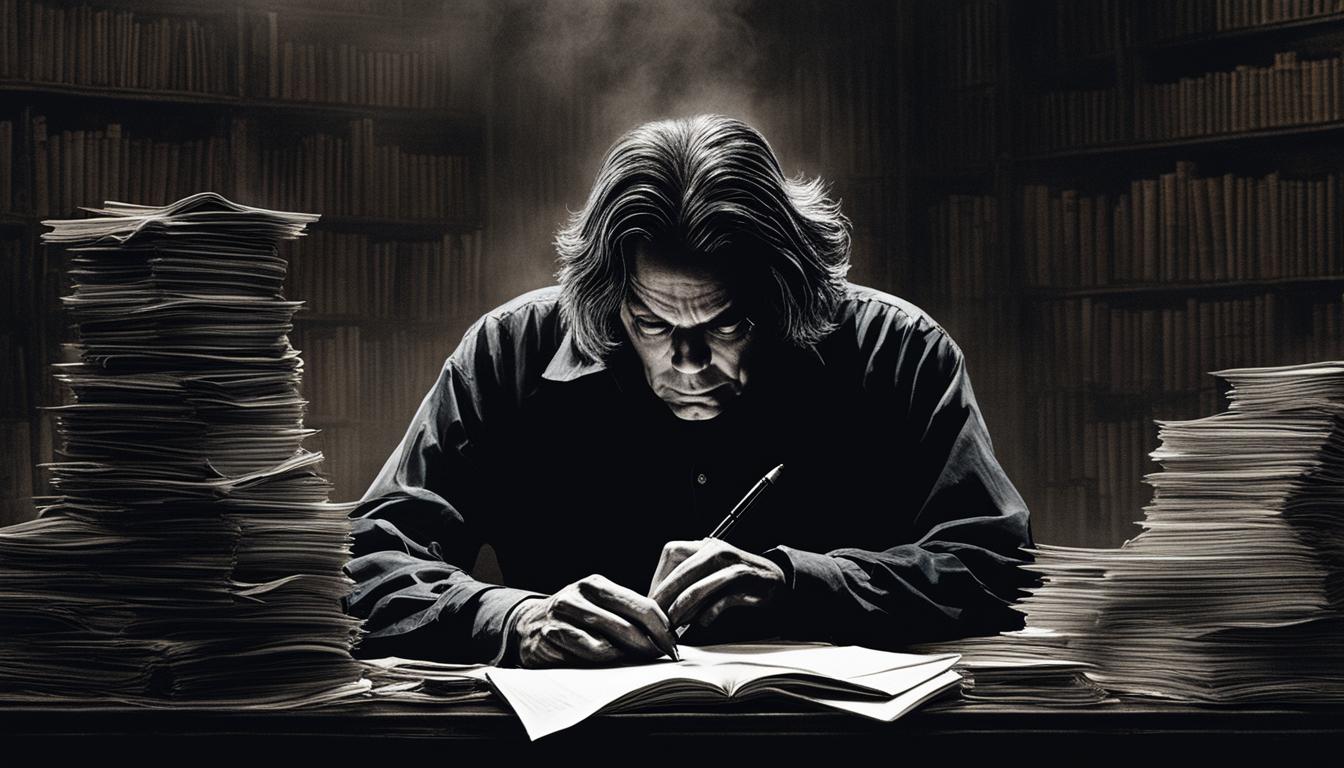Stephen King is a household name in the world of horror fiction, known for his bone-chilling tales that keep readers up at night. His stories are the stuff of nightmares, delving into the darkest corners of the human psyche and exploring the horrors that lurk beneath the surface. If you’re a fan of horror, then you know that nobody does it quite like Stephen King. With an impressive body of work spanning decades, King has established himself as one of the greatest writers of our time, earning critical acclaim and a legion of dedicated fans.
In this article, we’ll explore the best works of Stephen King, his early writing career, his rise to fame, and the impact he has had on popular culture. We’ll also delve into the dark themes and narrative techniques that make his stories so compelling and analyze the recurring themes of fear and humanity that run through his fiction. Whether you’re a die-hard fan or simply curious about his work, this article is for you. So settle in, turn down the lights, and prepare to enter the dark and twisted world of Stephen King.
Stephen King’s Early Writing Career
Stephen King’s journey to becoming a renowned author began in his early years. As a child, he was an avid reader of horror and science fiction novels, which sparked his interest in writing. He cites H.P. Lovecraft, Ray Bradbury, and Richard Matheson as major influences on his work.
During his teenage years, King wrote short stories and sold them to magazines, earning a few cents per word. In 1967, he enrolled at the University of Maine, where he continued to write and publish short stories, including “The Glass Floor” and “I Was a Teenage Grave Robber.”
In 1973, King’s first novel, Carrie, was published, marking a turning point in his career. The story of a teenage girl with telekinetic powers became a best-seller, launching King into the spotlight as a master of horror fiction.
King’s early works, such as Salem’s Lot and The Shining, helped establish his unique voice in the horror genre and paved the way for his later epic works, such as The Dark Tower series and It. Through his early writing career, King honed his craft and created a body of work that would capture the imaginations of readers for decades to come.
The Rise to Fame: Stephen King’s Breakthrough Novels
Stephen King is renowned for his captivating storytelling and ability to terrify his readers. He began to gain widespread recognition as a master of horror with the publication of his breakthrough novels, which solidified his position as one of the most important writers of his generation.
| Novel | Year Published | Synopsis |
|---|---|---|
| Carrie | 1974 | The story of a high school outcast who uses her newfound telekinetic powers to exact revenge on her tormentors. |
| The Shining | 1977 | A haunted hotel sets the stage for a father’s descent into madness, putting his wife and son in grave danger. |
| It | 1986 | The residents of Derry, Maine face a malevolent force in the form of a shape-shifting entity that preys on their deepest fears. |
These novels are beloved by fans and critics alike for their memorable characters, intricate plots, and expertly crafted scares. They catapulted King into the spotlight and paved the way for his enduring literary legacy.
Stephen King’s Dark Themes and Narrative Techniques
Stephen King’s fiction is characterized by its exploration of dark, often unsettling themes that range from psychological terror to supernatural horror.
One of King’s most effective narrative techniques is his ability to draw readers into his stories and make them feel like they are living through each terrifying moment. Through vivid descriptions and masterful pacing, King creates a sense of dread that builds gradually until it culminates in a shocking conclusion.
An example of King’s use of dark themes and narrative techniques can be seen in his novel, “Misery.” The story follows acclaimed author Paul Sheldon, who is held captive by his obsessive fan, Annie Wilkes, after a car accident leaves him stranded in a blizzard. As the story progresses, readers are taken on a psychological journey with Paul as he navigates his terrifying situation and attempts to escape Annie’s clutches.
In addition to “Misery,” King has explored a variety of other dark themes throughout his career, including addiction, death, loss, and grief. By tapping into these universal fears and desires, King is able to create stories that resonate with readers on a deeper level.
King’s narrative techniques are often characterized by their immersive and visceral nature, which is achieved through the use of sensory details and powerful imagery. This creates a sense of immediacy that draws readers into the story and keeps them engaged from start to finish.
| Dark Themes | Narrative Techniques |
|---|---|
| Psychological terror | Vivid descriptions |
| Supernatural horror | Masterful pacing |
| Addiction | Sensory details |
| Death | Powerful imagery |
| Loss | Immediacy |
| Grief | Engaging storytelling |
Overall, Stephen King’s use of dark themes and narrative techniques has made him one of the most popular and enduring authors in horror literature. His ability to tap into universal fears and desires, craft immersive stories, and create chilling suspense has cemented his place as a master of the craft.
The Impact of Stephen King’s Works on Popular Culture
Stephen King has left an indelible mark on popular culture, with his stories and characters becoming a fixture of the entertainment industry. Many of his novels have been adapted into films and television series, introducing his work to a wider audience and cementing his influence on popular media.
Some of the most iconic adaptations of King’s work include:
| Adaptation | Year |
|---|---|
| The Shining | 1980 |
| Misery | 1990 |
| The Shawshank Redemption | 1994 |
| It (2017) | 2017 |
| Doctor Sleep | 2019 |
In addition to film and television adaptations, King’s influence can be seen in a variety of other media, from video games to music. His characters and stories have become a part of the cultural lexicon, with references to King’s work appearing in everything from casual conversation to highbrow literature.
King’s impact on popular culture extends far beyond the entertainment industry. His writing has also influenced the broader cultural conversation around topics such as fear, trauma, and the human experience. His work has sparked discussions about the nature of horror and what it reveals about our collective psyche.
Stephen King’s contributions to popular culture have made him one of the most recognizable and respected writers of our time.
Stephen King’s Works Beyond Horror: Exploring His Range
Although Stephen King may be best known for his chilling horror stories, the author has also explored a diverse range of genres throughout his career. From science fiction to crime fiction, King’s versatility and range as a writer is on full display in his catalogue of works.
One notable example of King’s foray into science fiction is his novel The Running Man, which takes place in a dystopian future where a game show determines who lives and who dies. In the realm of crime fiction, King has written several novels under the pseudonym Richard Bachman, including The Long Walk and Rage.
But perhaps one of King’s most beloved non-horror novels is The Stand, a post-apocalyptic epic that explores themes of survival, human nature, and the struggle between good and evil. With a large and diverse cast of characters, cinematic scope, and a gripping narrative, The Stand has become a fan favorite and a testament to King’s ability to captivate readers across genres.
King’s ability to masterfully craft stories across genres has earned him critical praise and cemented his legacy as one of the most influential authors of his generation. His works beyond horror serve as a testament to his range and versatility as a writer, solidifying his place in the literary canon.
The Stephen King Universe: Interconnected Stories and Characters
Stephen King’s storytelling often goes beyond individual novels, connecting characters, locations, and events to create a shared universe. This interconnectedness adds depth and complexity to his narrative and creates a sense of community among his readers.
One of the most notable examples of Stephen King’s interconnected storytelling can be found in his “Dark Tower” series. The series spans eight novels and follows the quest of Roland Deschain, a gunslinger on a mission to reach the dark tower and save his world. The series contains references to many of King’s other works, including appearances from characters like Father Callahan from “Salem’s Lot” and Randall Flagg from “The Stand.”
Another example of connected storytelling in King’s works can be found in the town of Castle Rock, which appears in several novels, including “The Dead Zone” and “Needful Things.” Characters from one novel often make appearances in another, making the town feel like a real place with a rich history.

| Character | Novel(s) |
|---|---|
| Pennywise the Dancing Clown | “It” |
| Randall Flagg | “The Stand,” “The Dark Tower series” |
| Jack Sawyer | “The Talisman,” “Black House” |
| Alan Pangborn | “Needful Things,” “The Dark Half,” “The Sun Dog” |
In addition to creating a sense of community among his readers, King’s interconnected universe adds layers of meaning to his works. Recurring characters and themes allow readers to track the evolution of King’s ideas over time, potentially shedding new light on older works as the universe expands.
As King continues to add to his connected universe, it remains a testament to his skill as a world-builder and his ability to create lasting, memorable characters and stories.
Themes of Fear and Humanity in Stephen King’s Fiction
Stephen King is a master at weaving tales of fear and horror that resonate with readers on a fundamental level. His stories tap into the fears and anxieties that are part of the human experience, exploring themes of fear and humanity in ways that are both terrifying and deeply relatable.
One of the recurring themes in Stephen King’s fiction is the concept of fear itself. Whether it’s the fear of the unknown, the fear of death, or the fear of losing control, King captures the essence of what it means to be afraid and amplifies it to frightening new heights. This can be seen in works like The Shining, where the Overlook Hotel becomes a physical manifestation of the protagonist’s terror, or in It, where the titular monster preys on the deepest fears of its victims.
Another theme that runs through much of King’s work is humanity. Despite the supernatural and often horrific elements of his stories, King never loses sight of his characters’ humanity. His protagonists are flawed and complex, struggling with their own inner demons even as they face external threats. This human element adds depth and resonance to King’s stories, making them more than just simple tales of terror.
| Stephen King Novels | Themes of Fear and Humanity |
|---|---|
| The Stand | Apocalyptic fears and the struggle for survival |
| Salem’s Lot | The fear of vampires and the corruption of innocence |
| The Dead Zone | The fear of the future and the burden of power |
| 11/22/63 | The fear of changing the course of history and the power of love |
King’s ability to tap into our deepest fears and explore the complexities of our humanity has made him one of the most beloved and enduring writers of our time. His works continue to frighten and inspire readers, offering a glimpse into the darkness that lies within us all.
Critically Acclaimed: Stephen King’s Award-Winning Works
Over the course of his prolific career, Stephen King has amassed an impressive collection of literary awards and critical recognition. His unique ability to craft intricate stories that are both chilling and emotionally resonant has earned him a dedicated following of fans and critics alike.
One of King’s most acclaimed works is his novel “Misery,” which won him the prestigious Bram Stoker Award for Best Novel in 1987. The story of a famous author held captive by his obsessive fan, the book is a masterful exploration of the blurred boundaries between reality and fiction.
Another of King’s critically acclaimed works is “The Green Mile,” a serialized novel that was later published in its entirety. The story of a group of death row inmates with supernatural abilities, “The Green Mile” won the British Fantasy Award for Best Novel in 1996.
King’s impact on popular culture has also been recognized by awards such as the National Medal of Arts, which he received from President Barack Obama in 2015. The medal recognized King’s contributions to American literature and his enduring legacy as one of the most important voices in modern horror fiction.
Stephen King’s Enduring Legacy and Influence on Horror Literature
Stephen King’s impact on horror literature is immeasurable. His storytelling prowess, ability to tap into readers’ deepest fears, and his exceptional world-building have earned him a place as one of the most important figures in the genre. His influence is not just limited to horror but extends to popular culture as well.
His works have inspired countless authors and filmmakers and have given rise to a new wave of horror that continues to push the boundaries of the genre. The legacy of Stephen King is not just in the sheer number of his works or in the many adaptations of his stories but also in the way he has changed the landscape of horror itself.
The enduring legacy of Stephen King has left an indelible mark on the literary world. His ability to craft compelling characters, create chilling suspense, and explore universal themes of fear and humanity has ensured that his works will continue to captivate readers for generations to come, cementing his status as a true literary icon.

| Impact | Examples |
|---|---|
| Inspiring other writers | Clive Barker, Neil Gaiman, Joe Hill |
| Movie and TV adaptations of his works | The Shining, It, Carrie |
| Spawning a new wave of horror | Stranger Things, American Horror Story, The Haunting of Hill House |
Conclusion
Stephen King’s reputation as the master of horror is well-deserved, and his dark and gripping works continue to captivate audiences around the world. Through exploring his early career, breakthrough novels, and range of writing, it’s clear that King’s influence on literature and popular culture is vast. His ability to tap into the deepest fears and struggles of humanity, while employing masterful narrative techniques, has cemented his place as one of the most important and enduring figures in horror literature.
As we reflect on Stephen King’s legacy, it’s evident that he has had a profound impact on the genre and inspired countless writers to follow in his footsteps. King’s work will undoubtedly continue to terrify and enthrall readers for generations to come, ensuring his place as a true icon of American literature.
Thank you for reading about Stephen King and his many contributions to the literary world.



